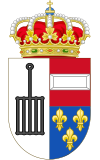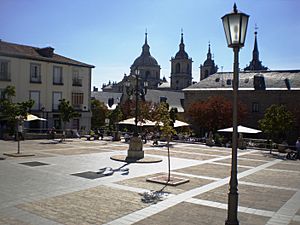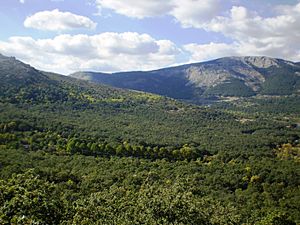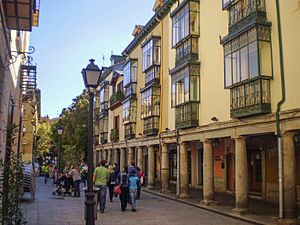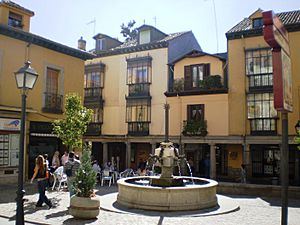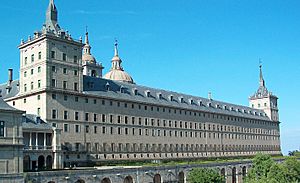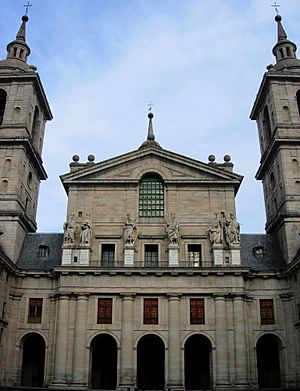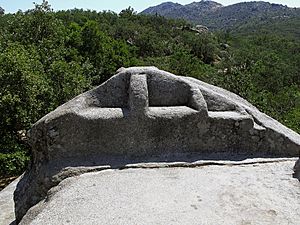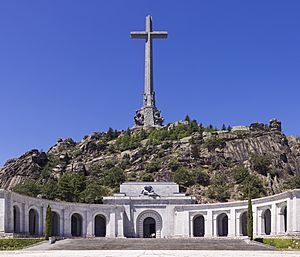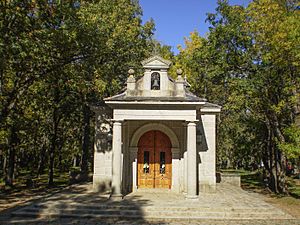San Lorenzo de El Escorial facts for kids
Quick facts for kids
San Lorenzo de El Escorial
|
|||
|---|---|---|---|
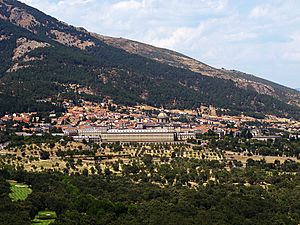 |
|||
|
|||
| Country | Spain | ||
| Autonomous community | Community of Madrid | ||
| Province | Madrid | ||
| Comarca | Sierra de Guadarrama | ||
| Founded | 18th century | ||
| Area | |||
| • Total | 56.4 km2 (21.8 sq mi) | ||
| Elevation | 1,032 m (3,386 ft) | ||
| Population
(2018)
|
|||
| • Total | 18,088 | ||
| • Density | 320.71/km2 (830.6/sq mi) | ||
| Demonym(s) | Sanlorentinos / Gurriatos 1960-2003 Ardillas | ||
| Time zone | UTC+1 (CET) | ||
| • Summer (DST) | UTC+2 (CEST) | ||
| Postal code |
28200
|
||
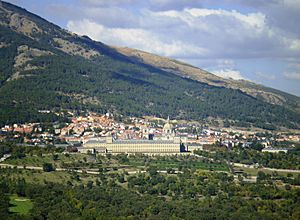
San Lorenzo de El Escorial is a town and town area in Spain. It is located in the Community of Madrid, which is like a state or region in Spain. This town is found in the northwest part of the region, at the base of Mount Abantos. It is about 47 kilometers (29 miles) from Madrid. People sometimes call it "El Escorial de Arriba" to tell it apart from the nearby village of El Escorial, which is known as "El Escorial de Abajo."
The most famous building in San Lorenzo de El Escorial is the Monastery of El Escorial. It is one of Spain's most important Renaissance buildings. Inside, the Royal Library is especially amazing.
The monastery and the area around it were named a World Heritage Site by UNESCO on November 2, 1984. This means it is a very important place for everyone in the world to protect. The site is also protected by Spain's own heritage rules.
San Lorenzo de El Escorial sits on the southern side of Mount Abantos, which is 1,753 meters (5,751 feet) high. Most of the town is about 1,000 meters (3,281 feet) above sea level. The town first grew around the Monastery and then spread up the mountain. In recent years, it has grown a lot, especially towards the southeast side of Mount Abantos.
Contents
- Exploring San Lorenzo de El Escorial's Geography
- A Look at San Lorenzo de El Escorial's History
- Population and Economy of San Lorenzo de El Escorial
- Main Sights and Historical Places
- Famous People from San Lorenzo de El Escorial
- Festivals and Traditions in San Lorenzo
- Learning and Education in San Lorenzo
- Images for kids
- See also
Exploring San Lorenzo de El Escorial's Geography
How High is the Town and Its Waterways?
The town's average height is about 1,032 meters (3,386 feet) above sea level. The Monastery itself is about 28 meters (92 feet) higher than the town. The very highest point in the area is the top of Mount Abantos.
The town covers an area of 56.4 square kilometers (21.8 square miles). Most of this land is mountainous. To the south, there is a natural bowl-shaped area called the Circo de El Escorial. This area is surrounded by Mount Abantos and the Las Machotas hills.
San Lorenzo de El Escorial is in the area where water flows into the Guadarrama River. The Aulencia River, which starts in Las Machotas, is the main river that flows into the Guadarrama. There are also small streams and reservoirs in the area.
Discovering the Local Plants
The types of plants you see here change depending on how high up you are. In the lower areas, around 914 meters (3,000 feet), you'll find grassy fields with narrow-leafed ash trees. In the La Herrería forest, there are Pyrenean oaks, sweet chestnuts, and Montpellier maples.
Higher up, between 1,000 and 1,200 meters (3,281–3,937 feet), you can see maritime and stone pines. There are also holm oaks, prickly junipers, and labdanum plants. Even higher, up to 1,219 meters (4,000 feet), Scots pine and black pine grow.
San Lorenzo de El Escorial also has some trees that are not originally from this area. These include beech, cedars, larches, Lawson cypresses, and sycamores. Students from a forestry school planted these trees in the early 1900s.
Some trees are historically important, like the giant sequoias. These huge trees were planted in the 1700s in the gardens of the Casita del Príncipe.
A large part of the town is within the "Abantos pine forest" and the Herrería zone. This area has been a protected nature spot since 1961.
The Arboreto Luis Ceballos is an environmental education center. It has over 200 types of trees and bushes that are native to Spain and the Balearic Islands.
A Look at San Lorenzo de El Escorial's History
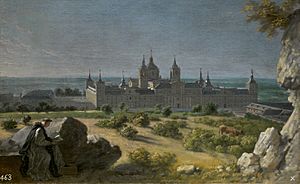
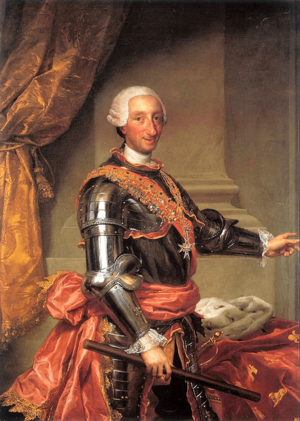
The story of San Lorenzo de El Escorial is closely tied to the building of the Monastery. The first records of this huge project are from 1558. King Philip II of Spain put together a team of architects, doctors, and builders to find the perfect spot for it.
The village of El Escorial was chosen because it had everything needed. There were plenty of forests, stone quarries, and good hunting areas. The water was clean, and it was in the center of Spain, at the foot of Mount Abantos. The final decision was made in 1561.
The first stone of the Monastery was laid on April 23, 1563. A year before, King Philip II started buying land around the future Monastery. He wanted to create a "Royal Site" for farming, fishing, hunting, and fun. This included the La Herrería forest, which is in San Lorenzo de El Escorial today.
Building the Monastery took 21 years. This changed the village of El Escorial a lot. It became a "villa" (a small town) in 1565, ruled by a Lord Mayor.
In the 1700s, King Carlos III brought in new rules for the area. People wanted to build more houses near the Monastery, but this was not allowed. King Carlos III stepped in and, on May 3, 1767, allowed houses to be built next to the Monastery's market. This was the start of the town of San Lorenzo de El Escorial. It grew very quickly, with over a thousand people living there just a few years later.
San Lorenzo de El Escorial became its own independent town on September 26, 1836. In 1887, the town elected its first mayor.
During the Spanish Civil War (1936–1939), the town supported the Republican government. For a short time, its name was changed to El Escorial of the Sierra.
Population and Economy of San Lorenzo de El Escorial
Who Lives in San Lorenzo de El Escorial?
In 2008, San Lorenzo de El Escorial had 17,346 people living there. This means about 307 people lived in each square kilometer. This is similar to other nearby towns but much lower than the average for the whole Community of Madrid.
The town has a mix of cultures, with many people from Morocco and Latin America. In 2006, slightly more than half of the residents were women. About 10% of the total population were from other countries. The average age of people living here was 37.8 years old.
Many people visit San Lorenzo de El Escorial. It's a popular place for second homes, where people stay on weekends and holidays. Also, many tourists come every day to see its historical sites and beautiful nature.
| 1996 | 1998 | 1999 | 2000 | 2001 | 2002 | 2003 | 2004 | 2005 | 2006 | 2007 | 2008 | 2022 |
|---|---|---|---|---|---|---|---|---|---|---|---|---|
| 10,828 | 10,995 | 11,350 | 11,783 | 12,455 | 13,164 | 14,358 | 14,971 | 14,364 | 16,005 | 16,531 | 17,346 | 18,423 |
How Does the Town Make Money?
Tourism, hotels, and shops are the main ways San Lorenzo de El Escorial makes money. It is one of the most important places for tourists to visit in the community of Madrid. Many visitors come for day trips from Madrid. Not many tourists stay overnight, unlike in other historical cities.
Recently, the town has tried to get more people to stay in hotels. They also want to host trade fairs, meetings, and cultural courses. For example, the Universidad Complutense holds summer courses here. In 2006, the town had 10 hotels with a total of 611 rooms.
Two of Spain's most visited monuments are in this municipality. The Monastery of El Escorial is the second most visited monument in Spain. The Valle de los Caídos (Valley of the Fallen), just outside town, is the third most visited.
Building new homes is also a growing part of the economy. Even though much of the area is protected, the town has grown a lot in recent years. New neighborhoods have been built, especially on the southeastern side of Mount Abantos. This growth happened partly after a large forest fire in 1999.
Main Sights and Historical Places
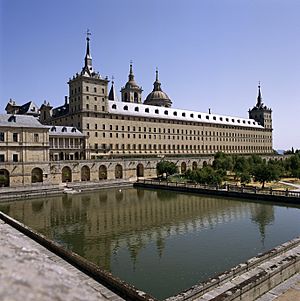
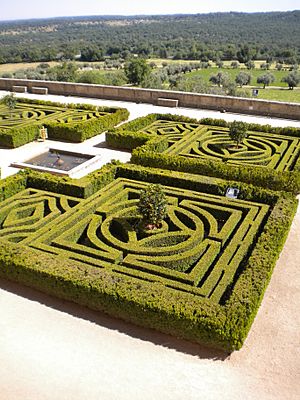
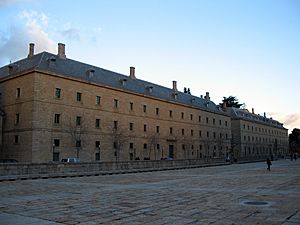
The town has many important historical, artistic, and cultural sites. These are all thanks to its connection with the Spanish royal family. It also has important natural, geological, and archaeological features.
Part of the area is on the UNESCO heritage list. This means it's recognized as a very important place globally. The site is also protected by the community of Madrid as a "Property of Cultural Interest."
UNESCO World Heritage Sites in San Lorenzo
On November 2, 1984, UNESCO added "El Escorial, monastery and site" to its World Heritage List. This happened during the 400th anniversary of the Monastery's construction.
This special listing protects several key places:
- The Monasterio de El Escorial: This huge building is one of Spain's most important Renaissance monuments. It was built in the late 1500s on the side of Mount Abantos. The project was started by Juan Bautista de Toledo and finished by Juan de Herrera. The Monastery covers a large area and has many courtyards, fountains, chapels, cloisters, and rooms. Important parts include the Pantheon of Kings, the Basilica, and the Royal Library. Since the 1500s, it has been called "the eighth wonder of the world."
- The Casita of Infante and the Casita del Príncipe: These are two beautiful 18th-century mansions. They were built by Juan de Villanueva as places for Carlos IV (who was then a prince) and his brother, Infante Gabriel of Spain, to relax.
Spain is working to expand the UNESCO World Heritage area. They want to include all the land that King Philip II originally set aside for the royal site.
Other Important Historical Places
The town of San Lorenzo de El Escorial is part of a larger historical area. This area is called "El Escorial: monastery, site and natural and cultural environment." It includes other towns like El Escorial, Zarzalejo, and Santa María de la Alameda.
Here are some of the important places in San Lorenzo:
- Seat of Philip II: Legend says King Philip II sat here to watch the Monastery being built. However, it might have been an ancient altar from before Roman times.
- The Herrería: This is a historic farm with beautiful nature, full of ash and oak forests.
- Del Castañar: Another historic farm with lovely natural areas.
- Park of the Casita: These parks and gardens are shared between San Lorenzo de El Escorial and El Escorial.
- Houses of Offices: The first two were built in the 1500s by Juan de Herrera. The third was built in the 1700s by Juan de Villanueva. Today, they house a church, the town's cultural center, the library, the tourist office, a music conservatory, and an arts center.
- Houses by Juan de Villanueva: These include the Casita del Infante and the Casita del Príncipe.
- Royal Colosseum of Carlos III: Built in the 1700s, this theater is also known as the "Bombonera theatre."
- The Company Home: Designed in the 1500s, it is now home to the University Maria Cristina.
- The Valley of the Fallen: This memorial was built in the 1900s. It has a huge cross, a basilica carved into the stone, an abbey, and an inn. The cross is 149 meters (490 feet) tall.
Famous People from San Lorenzo de El Escorial
San Lorenzo de El Escorial has strong ties to the Spanish royal family. Many kings and queens from the Habsburg and Bourbon families lived and were buried here.
Because kings were often here, many famous artists and cultural figures also came to the town. For example, the musician Antonio Soler (1729–1783) died here after spending most of his career in San Lorenzo.
In the 19th and 20th centuries, the town became a popular place for important politicians and artists from Madrid to live. This included the famous comedy writers Serafín and Joaquín Álvarez Quintero, who lived here for a time.
Some notable people born in San Lorenzo de El Escorial in the 20th century include the poet Luis Felipe Vivanco (1907–1975), the architect Juan Herreros (born 1958), and the botanist Luis Ceballos y Fernández de Córdoba (1896–1967).
Festivals and Traditions in San Lorenzo
The people of San Lorenzo celebrate their main festivals on August 10. This is the feast day of Saint Lawrence. King Philip II of Spain dedicated the El Escorial Monastery to this saint. The town is named after him because the Monastery was built to remember a victory in the Battle of St. Quentin, which happened on August 10, 1557.
The pilgrimage of Our Lady, Virgin of Grace, is a very important tradition in San Lorenzo de El Escorial. It takes place in early September. Since 1948, the community of Madrid has recognized it as a special tourist attraction.
Holy Week in San Lorenzo is known for its beautiful processions and events. During Christmastime, many people gather in the streets to see the Bethlehem nativity scene, which shows where Christ was born.
Learning and Education in San Lorenzo
San Lorenzo de El Escorial has several schools and learning centers. There are 5 nurseries (2 public and 3 private) for very young children. For older kids, there are 2 public primary schools and 1 secondary school. There are also 3 private schools.
The town also has a special center for international students and a university center. This university center is connected to the Complutense University.
Images for kids
-
Portrait of Ferdinand VII of Spain in coronation robes by Francisco Goya
See also
 In Spanish: San Lorenzo de El Escorial para niños
In Spanish: San Lorenzo de El Escorial para niños



